Abstract
Objective. To evaluate the impact of an innovative team-taught elective course on second-year (P2) students’ knowledge and skills relating to the relationship between aromatherapy and pharmacy.
Design. An Aromatherapy Science elective course was offered to P2 students in an accelerated doctor of pharmacy (PharmD) degree program and was designed to provide an elective course experience while focusing on active-learning skills such as group work, student-led presentations, and in-class activities. Lectures were designed to reinforce core curricular threads from the basic sciences within the pharmaceutical sciences department while highlighting key aromatherapy principles.
Assessment. Course evaluations, grades, and student self-assessments were used to evaluate student fulfillment and knowledge gained. Students agreed this hands-on course integrated pharmaceutical science experiences, enriched their pharmacy education, and provided knowledge to enhance their confidence in describing essential oil uses, drug interactions, and key aromatherapy clinical implications.
Conclusion. Students agreed this course prepared them to identify essential oil therapeutic uses and potential essential oil-drug interactions, and interpret literature. The introduction of aromatherapy principles to pharmacy students will prepare a new generation of healthcare professionals on the role of alternative medicines.
Keywords: elective course, pharmaceutical sciences, aromatherapy, active learning
INTRODUCTION
Aromatherapy is a vastly growing market in the United States, resulting in more than 31 million dollars in sales in 2012.1 While many associate this trade with the spa industry, aromatherapy has seen a rise in the use of therapeutic oils as shown by the increased number of registered aromatherapists over the past 3 years. While studies remain ongoing about the clinical benefits of essential oils, aromatherapy may enhance the quality of life and even serve as a complementary treatment to reduce stress, pain, nausea, and depression.2-5
A joint survey by the National Center for Complementary and Alternative Medicine and the National Center for Health Statistics reported that 38.3% of Americans use some type of complementary and alternative medicine (CAM).2 With this increased use of natural health products, such as herbal medicines and mineral supplements, healthcare professionals play an important role in educating patients on the proper uses and potential interactions of these oils. Consumers of these natural products turn to pharmacists, in particular, for information and guidance on these complementary medicines.6,7
Because pharmacists are seen as easily accessible and one of the most trusted healthcare professionals among patients,8 it is imperative that they are equipped with the knowledge to guide and counsel patients on complementary medicines.9,10 However, many practitioners admit that they are unfamiliar with many CAM approaches that their patients use.11 There is a need to incorporate this education into pharmacy students’ curriculum.12
Colleges and schools of pharmacy are required to offer a wide range of pharmacy elective courses according to Standard 10 of the Accreditation Council for Pharmacy Education.13 This allows students to develop skills and enhance knowledge in areas of personal interest and expand their understanding of opportunities in the profession. Additionally, this ensures that students become competent in areas of ever-changing healthcare environments. This includes areas such as alternative medical treatments as well as the evaluation of alternative and complementary medicine purity, bioavailability, safety, and efficacy.
With the increase in alternative medicine and essential oil use,14 pharmacists today require knowledge of alternative sources of healing and potential medication interactions.9,10 While courses on CAM are increasing, we could not find a description of a pharmacy elective course related specifically to aromatherapy.15 The purpose of this novel course was to introduce pharmacy students to aromatherapy as a form of alternative medicine and discuss the potential for essential oil and drug interactions through active learning. The primary goal of this course was to develop and/or improve students’ knowledge in the discipline of aromatherapy science as it related to their pharmacy educational experience. The course was designed to use the pharmaceutical sciences faculty members’ areas of interest (ie, medicinal chemistry, calculations, pharmacology/toxicology, anatomy/physiology, biochemistry, pharmaceutics) to directly apply core curricular threads to aromatherapy principles. We have provided a framework for a simple and novel way to add an elective course to an established pharmacy curriculum.
DESIGN
A 2-hour Aromatherapy Science elective course was designed to cover common essential oils and their therapeutic uses, toxicity, bioactivity, contraindications, interactions, and relevant clinical studies. The curriculum at Sullivan University College of Pharmacy (SUCOP) is an accelerated 3-year Pharm D degree program in which pharmacy students complete four 10-week quarters per year. Elective courses are available to students during each quarter of their second year of classroom-based coursework. Students are required to complete 6 elective courses during their second year.
The Aromatherapy Science elective course was offered to P2 students. The course outcomes listed below were formulated bearing in mind the core curricular threads for the pharmaceutical sciences department for PharmD students at SUCOP. The basic science course to which the outcome maps is included in parentheses.
• Acquire additional knowledge of alternative sources for healing and be informed of potential interactions of these alternative sources with patient’s medications and health conditions (pharmacology, medicinal chemistry);
• Explain the physiology of the science of smell and the psychological effects of aromatherapy (anatomy/physiology);
• Explain the natural physiologic effects of incense, perfumes, essential oils and cosmetics (pharmaceutics, medicinal chemistry, calculations, biochemistry);
• Identify the beneficial and/or therapeutic effects of essential oils and medical massage in the promotion of health and well-being (pharmacology);
• Identify safety issues in aromatherapy (toxicology);
• Complete a group project presentation on an aromatherapy topic.
The course design ensured that each basic science course was addressed in at least 1 of the course outcomes. In the first objective, students were to acquire knowledge on potential drug and essential oil interactions. Pharmacology/toxicology threads were reinforced while discussing the essential oils of sweet birch and wintergreen. Both contain the component methyl salicylate, which can potentiate the anticoagulant effect of warfarin. Therefore, there is the potential for drug interactions with these essential oils and warfarin. In the third objective, the effects of incense, perfumes, and essential oils were discussed. This was accomplished via several methodologies. Students synthesized their own rose essential oil in the laboratory through a distillation process (medicinal chemistry) and reviewed the monoterpene and sesquiterpene structures of many essential oils. They also participated in a hands-on blending of essential oils (pharmaceutics) and calculated ratios of pure essentials oils to the carrier oil in which they were diluted (calculations). Biochemistry threads were woven throughout the course when discussing the antibacterial vs antifungal activity that many essential oils possess.
In addition to outcomes, course objectives were set so that students could achieve the following goals by the conclusion of the course. The objectives were for students to be able to:
• Discuss the historical background of medicinal aromatherapy practice.
• List the common essential oils used in medical facilities and those commonly available in most pharmacies.
• Explain the physiology of aromatherapy through the use of the sense of smell.
• Explain the physiological uses of incense, perfume, and cosmetics.
• Explain the chemistry of essential oils and its bioactivity.
• Discuss the beneficial effects of massage in the promotion of health.
• Predict interactions of essential oils, conventional medicine, and clinical studies.
• Demonstrate the ability to discuss the health and medical advantages of aromatherapy practice.
The Aromatherapy Science elective course met once weekly for 2 hours during the winter quarter of 2013. Enrollment was limited to 20 students, which was approximately one fifth of the class. The course was held in a classroom with movable tables and chairs to foster classroom discussion and communication as opposed to a structured, tiered lecture hall. Students had full Internet access to online databases (Natural Standard, Access Pharmacy, Clinical Key, and Micromedex) and several aromatherapy textbooks supplied by the instructor (Table 1). Students enrolled in this course had completed their first year of pharmacy classroom-based work, which included anatomy/physiology, biochemistry, and pharmaceutical calculations, as well as 2 quarters of their second year, which included therapeutics and medicinal chemistry/pharmacology.
Table 1.
Student Resources for an Aromatherapy Science Elective Course
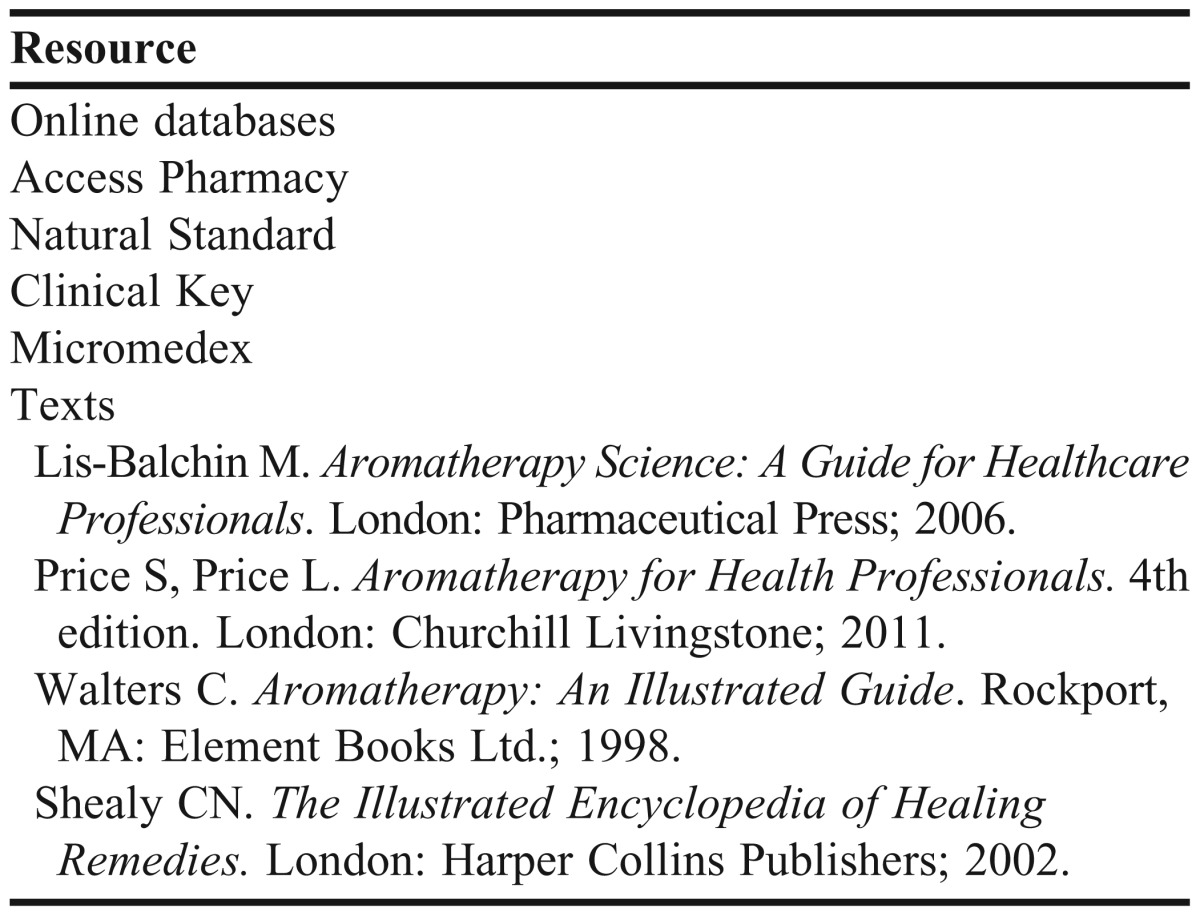
The course was developed and coordinated by a pharmaceutical science faculty member with a doctor of philosophy in pharmacology and toxicology and included lecturers from the pharmaceutical sciences department. During the proposal for the course design, the course coordinator contacted a local massage therapy school (Spencerian College, Louisville, KY) to identify interest in participating in an aromatherapy science course. Our college of pharmacy is fortunate in that Spencerian College falls under the larger umbrella of schools belonging to the Sullivan University System, which includes the College of Pharmacy. A licensed massage therapist (LMT) was identified and asked to participate in the course by providing a 2-hour lecture on the basics of essential oil uses and conducting an essential oil blending activity. This connection allowed for a cross-discipline relationship.
The course used a variety of teaching and learning methods including lecture, class activities, laboratory demonstrations, small journal clubs, and student presentations. Students also worked together to practice calculations, analyze hazardous symbols and risk phrases associated with oils and safety data, and execute literature searches. As mentioned, students were able to work directly with a licensed massage therapist during an active-learning essential oil blending class. Students chose from a wide variety of pure essential oils that were provided by the massage therapist and blended them into their own mixture using a carrier oil to dilute the concentrated essential oils.
Students were encouraged to engage in peer presentations and interject comments and/or questions when needed because peer evaluations comprised 5% of the students’ overall presentation grade. Faculty lecture reviews were formatted in a question-and-answer response style that fostered participation. Other faculty members commonly used probing questions throughout their lectures to encourage student engagement. Students reported that this interactive approach contributed to their learning, while also incorporating several types of learning styles: auditory (lectures, presentations), visual (demonstrations, laboratory), and kinetic (hand-on laboratory and essential oil blending).
Through lecture and active learning, core curricular threads from across basic science disciplines were reinforced in the Aromatherapy Science elective course. These curricular threads included extracting rose oil through distillation in the laboratory (medicinal chemistry), calculating essential oil volumes and ratios for blending (pharmaceutical calculations), designing their own essential oil mixture (pharmacology), and science of smell (pathophysiology). Specific lectures and objectives are listed in Table 2. For example, in lecture 6, students used their sense of smell when selecting 3 to 4 essential oils to use in combination with carrier oils. In lecture 2, students learned that essential oils are referred to as top, middle, or low “notes” based on their aromatic qualities. Top note oils are light, airy, stimulating, and energizing oils that are fresh and intense but fade quickly because of rapid evaporation. Base notes are rich and heavy, and the last to evaporate from a blend. Based on top-, middle-, and low note-ratio calculations, selected drops of essential oils were added to a grapeseed carrier oil to achieve an appropriate blend. An example of a synergy blend would be a 3:2:1 proportion of basil (top note), rosemary (middle note), and patchouli (base note) essential oils. An example of a question assessing blended ratios was: “Assuming 1 mL of essential oil=20 drops, calculate the quantity or volume of each essential oil required to make 3 fluid ounces of an aromatherapy blend: Essential oil X=3 parts, Essential oil Y=2 parts, and Essential oil Z=1 part.” Students’ blended oils were maintained in amber or blue vials for protection from light to avoid chemical degradation.
Table 2.
Integration of Aromatherapy Science Principles and Pharmacy Curriculum into Aromatherapy Science Elective Course Lectures
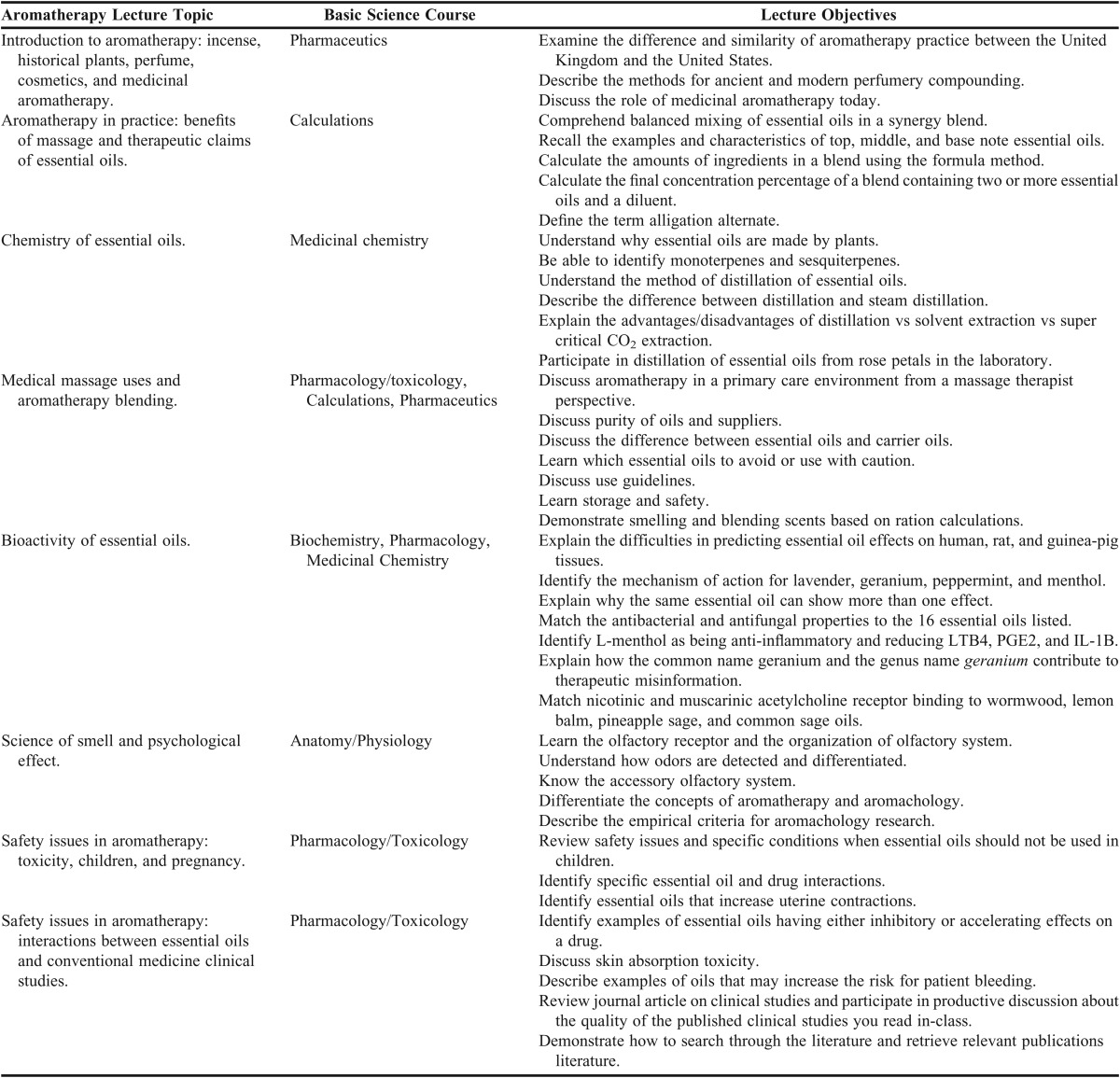
At the beginning of the course, students were given a list of more than 100 essential oils to review in preparation for choosing a specific essential oil for presentation and discussion with the entire class. Students worked in groups of 2 to 3 for this project. Class presentations were 10 minutes in length and used PowerPoint handouts and visual aids. Essential oil topics presented by the students included sassafras oil, cannabis flower essential oil, citrus oils, rosemary oil, ylang ylang oil, German chamomile oil, and frankincense.
EVALUATION AND ASSESSMENT
Two examinations were administered during the course to assess student knowledge and to ensure curricular content was retained and could be applied: a midterm examination (35% of final grade) and a noncumulative final examination (35% of final grade). The 40-question midterm consisted of 10 questions from each lecture preceding the examination. The 50-question final examination consisted of 40 questions from 4 different lectures (written and submitted in the same way as the midterm examination) and 10 questions concerning a key point from each of the student presentations (written by the coordinator). Examinations included a variety of question formats: multiple-choice, matching, and case-based questions. Most application-based multiple-choice questions focused on essential oil therapeutic uses, structure identification, mechanism of action, safety, and potential drug interaction content. Other faculty members used case-based questions to assess students’ ability to apply what they learned in the classroom.
A group presentation on an aromatherapy topic was also required for the course. This group project contributed 30% to each student’s final grade, with 25% of that based on the grading rubric completed by professors and 5% based on a peer assessment of each member of the group. Presentations were assessed using a grading rubric. The rubric encompassed the following specific content aspects: topic introduction, background, case study, conclusion, summary, and references, as well as organization, delivery, and content knowledge. Faculty members assessed students on their ability to apply and communicate key principles learned in the course while peer evaluations assessed group member participation. (Both rubrics are available upon request from the author.)
Overall course grades reflected that students comprehended material and all students successfully passed the course. In a class of 20 students, 15 achieved a grade of 90% or higher (A), 4 earned a grade of 80% or greater (B), and 1 student received a grade of greater than 70% (C).
At the completion of the course, Web-based perception and self-confidence survey instruments were administered by the course coordinator to students using SurveyMonkey, Inc. (Palo Alto, CA, www.surveymonkey.com) to assess student observations on a variety of outcomes from the Aromatherapy Science elective course. A standard course evaluation was also given by the Office of Academic affairs on a different date. Students were asked to complete 3 separate survey instruments. Completion of the survey instruments was highly encouraged but not mandated.
Students were given a 10-question self-efficacy assessment to report their confidence in aromatherapy knowledge as it related to the lecture objectives of the course (Table 3). For each question, students were asked to choose from the following responses: very confident, confident, unconfident, or very unconfident. Of the 20 students in the class, 19 completed the confidence survey instrument. Most responses fell into the confident category, while none of the students assessed themselves as very unconfident in the subject matter addressed. Students felt most confident in describing the history of essential oils; retrieving, analyzing, and interpreting literature regarding essential oil toxicities; and determining the clinical significance of essential oil and potential drug interactions.
Table 3.
Confidence Ratings for Student Self-Efficacy Assessment on Aromatherapy Science Elective Course Objectives
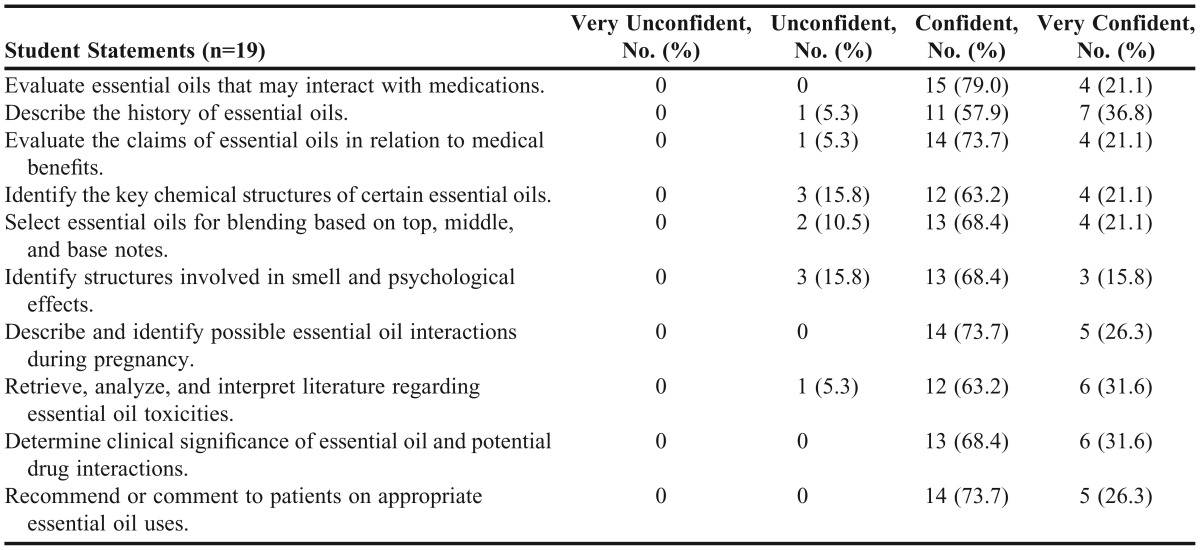
The evaluation administered by the course coordinator assessed perceptions on a variety of outcomes from the Aromatherapy Science elective course. This was separate from the institutional course evaluation described later. All 20 students who completed the course took part in the optional 11-question evaluation. Eight of the 11 questions used a Likert scale that allowed students to choose 1 of the following responses in reply to a statement about the course: strongly agree, agree, disagree, or strongly disagree (Table 4). The other 3 questions asked students to address why they chose to participate in the aromatherapy elective, and to list strengths of the course and areas for improvement Eighteen of 20 students chose to participate in the Aromatherapy Science elective course because it either interested them or because it enhanced their knowledge in the area of alternative medicine (Table 5). Overall, students “strongly agreed” with statements regarding the design of the course and its ability to provide a unique prospective while enriching the pharmacy curriculum. Most students in the class also reflected that grade assessment of the course was fair (80% strongly agreed, 20% agreed) and that the hands-on learning and class demonstrations overwhelmingly contributed to individual learning of a specified topic (90% strongly agreed, 10% agreed).
Table 4.
Pharmacy Student Responses to Course Coordinator Evaluation in an Aromatherapy Science Elective Course (N=20)
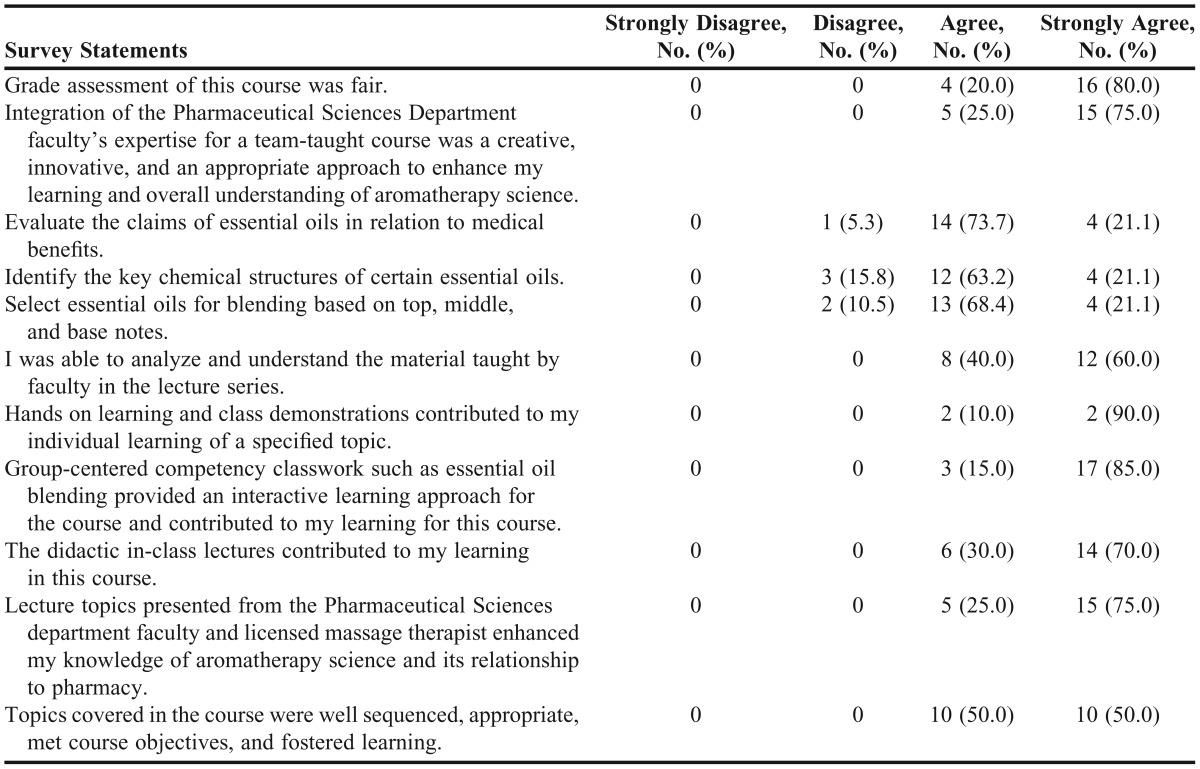
Table 5.
Pharmacy Student Participation in an Aromatherapy Science Elective Course (N=20)
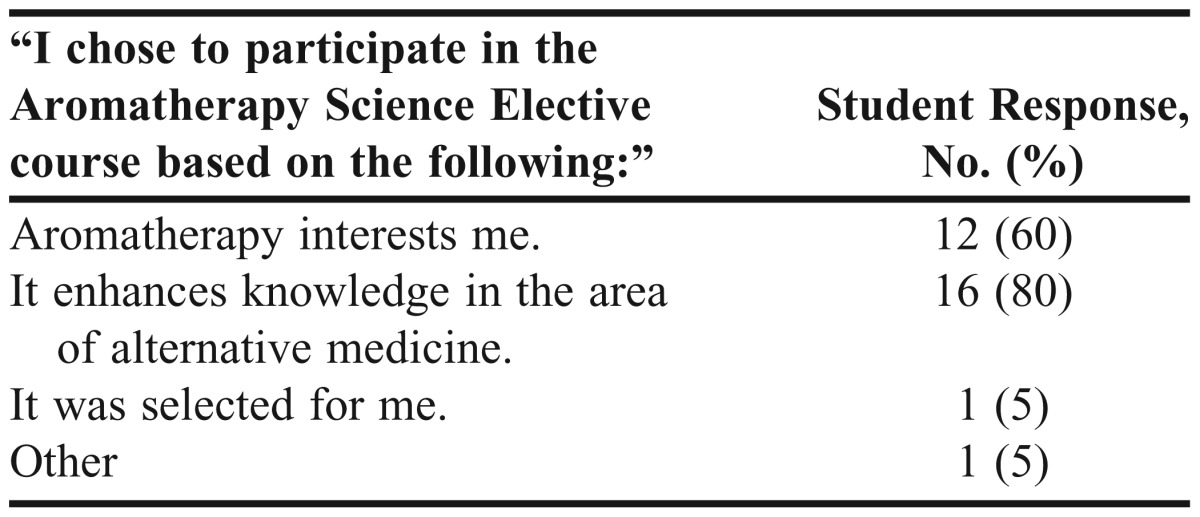
As mentioned, the Office of Academic Affairs administered a standard end-of-course evaluation at the conclusion of the quarter (Table 6). Eleven of 20 students in the course completed the 15-question evaluation in which 11 questions used the Likert scale similar to the course coordinator’s evaluation. Other questions included whether students felt the time they spent preparing for the course was appropriate, any strengths or areas in which improvement was needed, and other comments the students wished to add.
Table 6.
Standard College of Pharmacy Course Evaluation Participation Survey Response
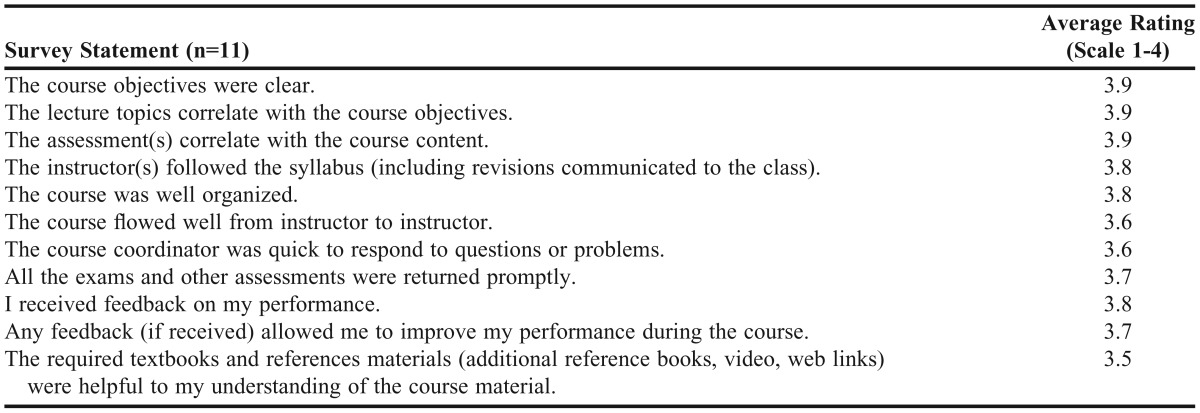
Although the response rate was only 55%, most students felt the coursework was fair, the objectives were clear, and the lecture topics correlated with the course objectives. Additionally, 63% of students who completed the survey instrument strongly agreed and 37% agreed that the course was well organized and flowed well from instructor to instructor. One student noted, “This course has allowed me to look beyond the scope of pharmacy practice [to] how patients use aromatherapy to treat their symptoms.”
DISCUSSION
Based on student responses on survey instruments, course evaluations, and self-assessments, and on course grades, the Aromatherapy Science elective course was a success. Students were enthusiastic about selecting this elective course and gaining knowledge on aromatherapy science as it related to the field of pharmacy. They reported enjoying learning about this form of alternative medicine. Most of the class agreed this course experience enriched their pharmacy education, while reinforcing their knowledge and awareness of drug interactions, pharmacy calculations, and the clinical implications of aromatherapy. Most students also agreed that the course prepared them to identify potential essential oil and drug interactions as well as to interpret literature on essential oil use. While the university-generated survey instrument yielded a lower student response rate than the course coordinator survey instrument, completion of the student survey instruments was not mandated as there was no penalty for not completing them. It could be possible that being asked to complete 3 survey instruments was overwhelming to students while they prepared for other course final examinations. Nevertheless, overall course grade distribution reflected that students comprehended the material and all students successfully passed the course.
Future development of this course will highlight the hands-on activities with less emphasis on drug history. Stronger relationships between alternative and modern medicines will be underscored as well as reinforcement of key chemical structures. Because this was a pilot course, limitations to our study are related to 1 set of data. Over the next 3 to 4 years, we will continue to offer this course and collect data for a prospective study and to increase the survey response rate.
Not only did this course provide students with a novel elective course experience, but it also laid the groundwork for a similar course to be executed at other colleges and schools of pharmacy. The design of this course may serve as a template to other pharmacy faculty members wishing to introduce a novel elective topic to their curriculum. By using the knowledge of several pharmaceutical science department faculty members, the workload can be shared while providing students with different learning environments and teaching approaches. The subject matter varied across the discipline while maintaining a focus on the science of aromatherapy and how it related to pharmacy. While access to a licensed massaged therapist may be a limiting factor for some colleges or schools of pharmacy wanting to implement a similar course, essential oils themselves may be purchased at any local natural foods stores or online. Prices vary depending on the selected essential oil and the quality of the oil. The price is usually determined by the amount of plant material needed for 1 fl oz. For instance, it takes approximately 5,000 pounds of rose petals to produce 1 pound of rose oil. There is a wide range of prices for pure essential oils; a 5-mL bottle of pure lavender essential oil costs $8 on average, while 1 mL of helichrysum pure essential oil can cost $75. Nonetheless, a course director would easily be able to obtain several less expensive oils for a blending exercise if they wished to implement a similar active-learning exercise. Additionally, the use of clinical science faculty members would help fulfill learning needs related specifically to patient care and communication on patient counseling.
CONCLUSION
The Aromatherapy Science elective course proved to be a successful, well-received experience that demonstrated student learning. The course provided active learning for students in an intimate classroom atmosphere in which they gained knowledge about aromatherapy. The introduction of aromatherapy and its relationship to pharmacy will create awareness among a new generation of healthcare professionals for alternative medicines and promote a potential niche for continuing education courses for community pharmacists in the future.
ACKNOWLEDGEMENTS
The authors acknowledge the following faculty members for their contributions to the Aromatherapy Science elective course: Dr. Maria Lourdes Ceballos-Coronel, Dr. David Cleary, Dr. Ajoy Koomer, Dr. Michael Smith, and Dr. Yuan Zhao. We also acknowledge Ms. Jennifer Stomberger for her essential oil expertise. Dr. Andrea Smith Franks and Dr. Daniel Malcom are acknowledged and much appreciated for their manuscript reviews and critiques.
REFERENCES
- 1.Petersen D. What's hot and what's not: US trends in aromatherapy essential oil choices. Paper presented at: Asian Aroma Ingredients Congress & Expo, Bali, Indonesia. 2012 [Google Scholar]
- 2.National Center for Complementary and Alternative Medicine. The use of complementary and alternative medicine in the United States. December 2008. http://nccam.nih.gov/news/camstats/2007/camsurvey_fs1.htm. Accessed August 23, 2013.
- 3.Cannard G. The effect of aromatherapy in promoting relaxation and stress reduction in a general hospital. Complement Ther Nurs Midwifery. 1996;2(2):38–40. doi: 10.1016/s1353-6117(96)80062-x. [DOI] [PubMed] [Google Scholar]
- 4.Louis M, Kowalski SD. Use of aromatherapy with hospice patients to decrease pain, anxiety, and depression and to promote an increased sense of well-being. Am J Hosp Palliat Care. 2002;19(6):381–386. doi: 10.1177/104990910201900607. [DOI] [PubMed] [Google Scholar]
- 5.Hunt R, Dienemann J, Norton HJ, et al. Aromatherapy as treatment for postoperative nausea: a randomized trial. Anesth Analg. 2013;117(3):597–604. doi: 10.1213/ANE.0b013e31824a0b1c. [DOI] [PubMed] [Google Scholar]
- 6.Braun L, Tiralongo E, Wilkinson J, et al. Perceptions, use and attitudes of pharmacy customers on complementary medicines and pharmacy practice. BMC Complement Altern Med. 2010;10(1):38. doi: 10.1186/1472-6882-10-38. [DOI] [PMC free article] [PubMed] [Google Scholar]
- 7.Steenfeldt L, Hughes J. An evidence-based course in complementary medicines. Am J Pharm Educ. 2012;76(10) doi: 10.5688/ajpe7610200. Article 200. [DOI] [PMC free article] [PubMed] [Google Scholar]
- 8.Kwan D, Boon H, Hirschkorn K, et al. Exploring consumer and pharmacist views on the professional role of the pharmacist with respect to natural health products: a study of focus groups. BMC Complement Altern Med. 2008;8(1):40. doi: 10.1186/1472-6882-8-40. [DOI] [PMC free article] [PubMed] [Google Scholar]
- 9.Chang ZG, Kennedy DT, Holdford DA, Small RE. Pharmacists' knowledge and attitudes toward herbal medicine. Ann Pharmacother. 2000;34(6):710–715. doi: 10.1345/aph.19263. [DOI] [PubMed] [Google Scholar]
- 10.Miller LG, Hume A, Harris IM, et al. White paper on herbal products. American College of Clinical Pharmacy. Pharmacotherapy. 2000;20(7):877–891. doi: 10.1592/phco.20.9.877.35200. [DOI] [PubMed] [Google Scholar]
- 11.Harris IM, Kingston RL, Rodriguez R, Choudary V. Attitudes towards complementary and alternative medicine among pharmacy faculty and students. Am J Pharm Educ. 2006;70(6):Article 129. doi: 10.5688/aj7006129. [DOI] [PMC free article] [PubMed] [Google Scholar]
- 12.Johnson T, Boon H, Jurgens T, et al. Canadian pharmacy students' knowledge of herbal medicine. Am J Pharm Educ. 2008;72(4):Article 75. doi: 10.5688/aj720475. [DOI] [PMC free article] [PubMed] [Google Scholar]
- 13.Accreditation Council for Pharmacy Education. Accreditation standards and guidelines for the professional program in pharmacy leading to the doctor of pharmacy degree. http://www.acpe-accredit.org/pdf/. Accessed August 13, 2013.
- 14.SPINS, Inc. Aromatherapy & Body Oils: Snapshot Report-Data Ending 03-17-12. Schaumberg, IL; 2012.
- 15.Jeffries WB. A fourth-year elective course in alternative medicine. Acad Med. 2001;76(5):525–526. doi: 10.1097/00001888-200105000-00060. [DOI] [PubMed] [Google Scholar]


